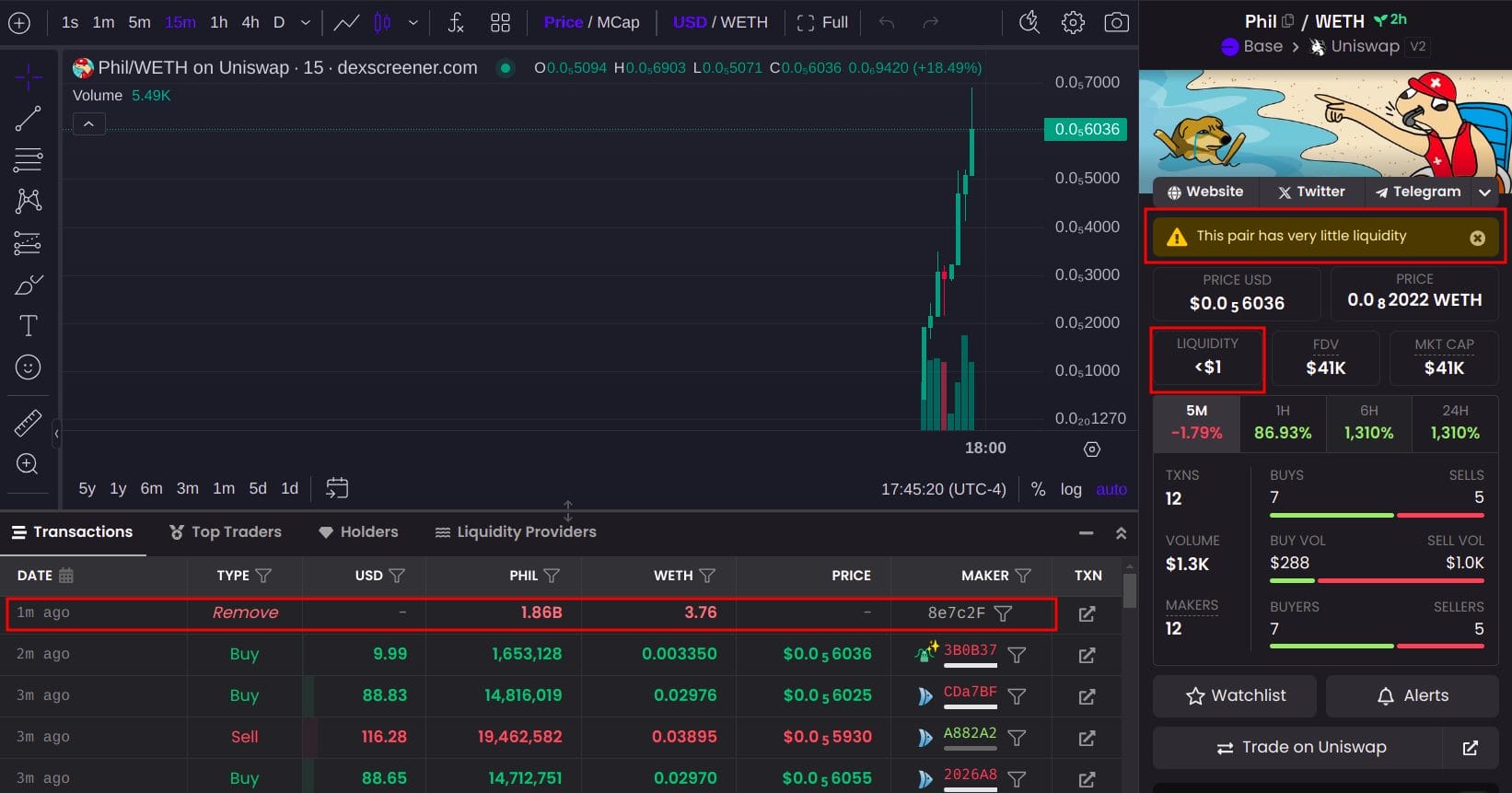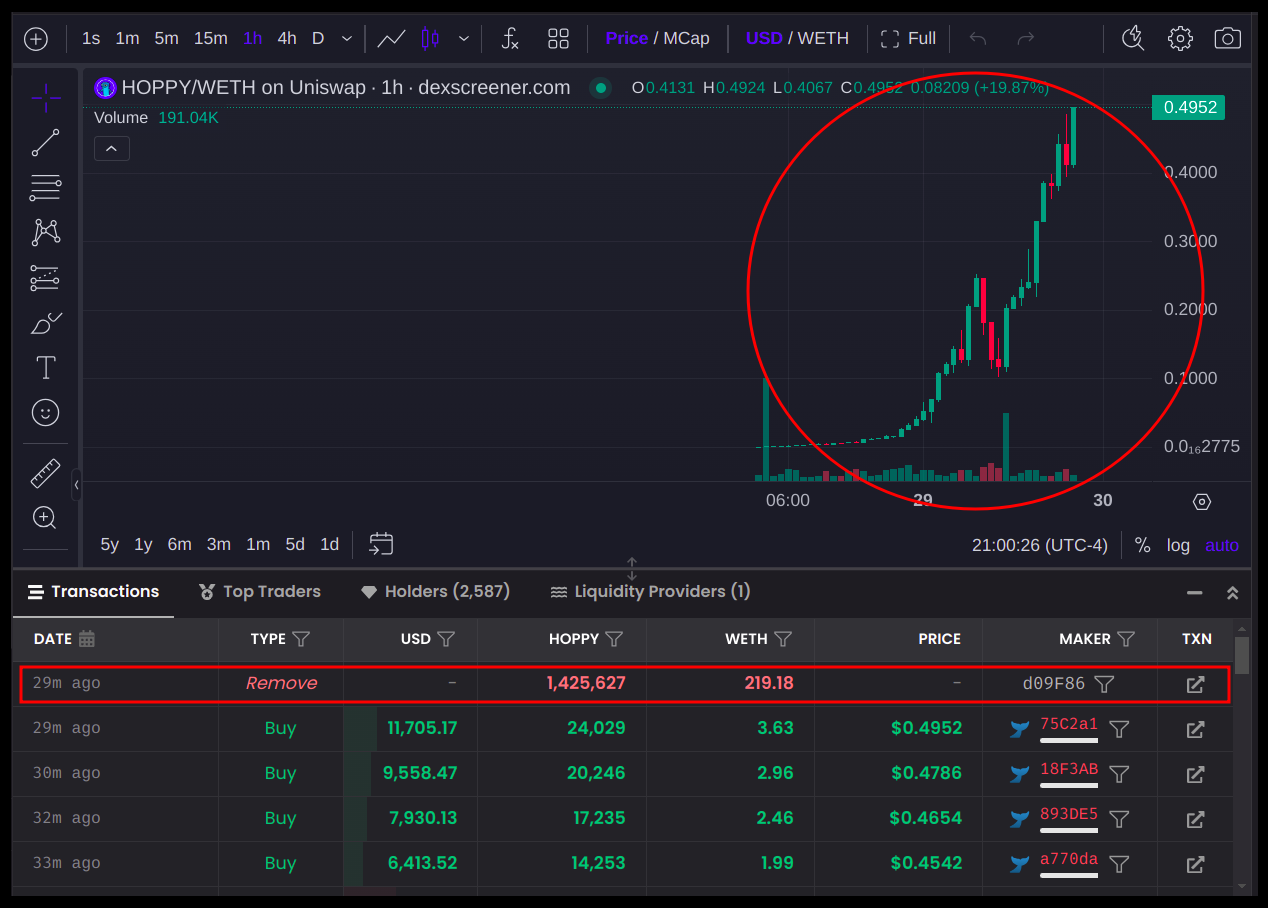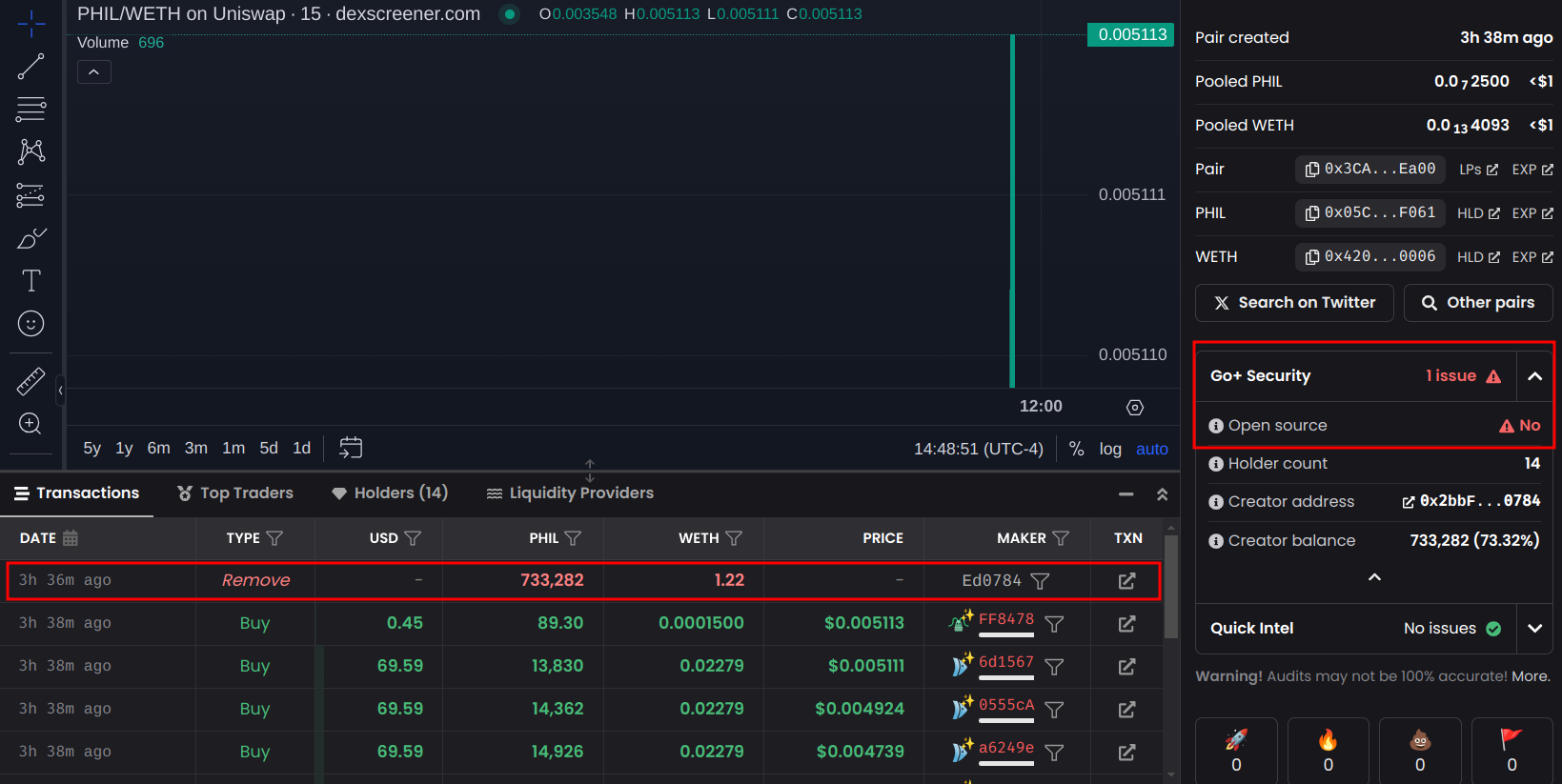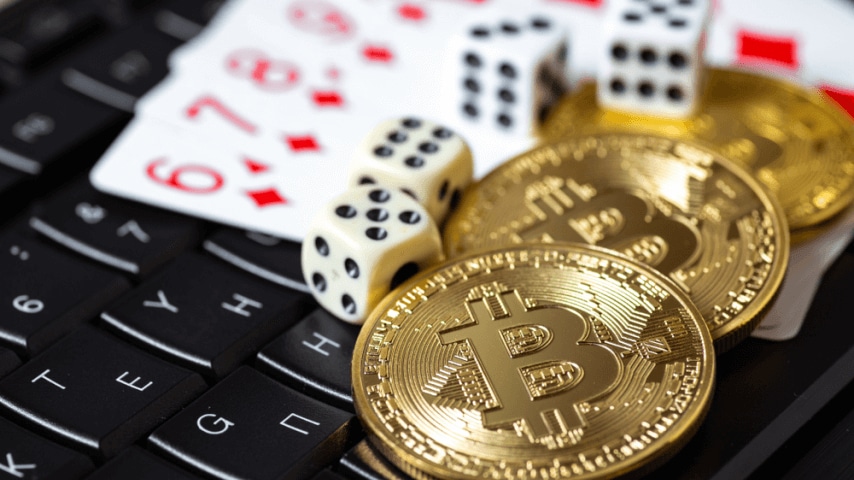What is a Rug Pull in Crypto? How to Avoid Them in 2024
Crypto offers life-changing profit opportunities, but that same fast-and-furious price action also attracts scams, often in the form of intentional rug pulls. In other cases, a project might just become abandonware if plans didn’t evolve as hoped. In this guide, we’ll answer the question, “What is a rug pull in crypto?” and pinpoint the most telling red flags.
As much as 90% of new-token rug pulls take place in the first two days after launch, preying on investors who want the 100x or higher gains that can come with early buys. However, there are some ways to spot potential exit scams and protect your trading capital for real opportunities. Let’s find out what a crypto rug pull is, how it works, and how to avoid becoming a statistic.
In Short: What is a Rug Pull?
A rug pull refers to when a developer or team pulls support for a project, leaving investors with worthless tokens or tokens worth considerably less than when supported by a seemingly viable project.
Rug pulls often follow a similar pattern: a person or team creates hype around a project or token to attract traders on decentralized exchanges (DEXs) who buy the token from a liquidity pool. These buyers exchange a valuable token like ETH or SOL for the newly launched token.
Then, liquidity for the project is removed, as shown below, making trading difficult or even impossible. The project owner or team disappears with the money.

In other cases, the team ends support for the project, or the team misses key development goals, causing prices to fall. The team might also dump their tokens, which would also cause prices to fall.
NFT rug pulls usually follow a familiar pattern. An NFT creator builds hype around a new NFT collection, drawing in investors who want to be part of an exclusive community of owners. Following the NFT minting (purchases with ETH or another crypto), the creator disappears with the money, and there is no community. All that remains are NFTs of now-dubious value.
Soft Rug Pulls vs. Hard Rug Pulls
Not all rug pulls are malicious or pre-planned scams, hence the distinction between soft rug pulls and hard rug pulls. Rug pulls also differ in the level of severity, with soft pulls perhaps offering a chance for recovery or at least more time to exit the position before the tokens become worthless.
Hard rug pulls, colloquially known as ‘rugs,’ are malicious and pre-planned. The developer, owner, or team intended to take money from investors, preying on their fear of missing out (FOMO).
What is a Soft Rug Pull?
Soft pulls can involve deceptive practices, such as inflating expectations or making false promises. In other cases, projects may simply be mismanaged, leading to a slow bleed as investors lose confidence. Team members themselves may sell tokens while they still have value.
These types of rug pulls often stem from initial good intentions that nonetheless went sideways and caused investors to lose money.
- False promises in marketing: Unlike stocks, crypto is largely unregulated, which opens the door to project teams or owners making inflated promises about tokens or projects. As time goes on, it becomes clearer that the project cannot reach its stated goals, and the token sells off.
- Not delivering full roadmap: A project roadmap lets investors know what is planned for the project so they can make an informed decision. However, teams may not be able to or lack the motivation to deliver on planned features or marketing activities that would give the token value. A single missed milestone can cause a selloff as investors lose confidence.
- Team dumping excessive amounts of tokens: Teams often get a handsome allocation of tokens at launch. If the team is selling into the market and has a large supply of tokens, the chart becomes less attractive, causing the token to lose its momentum and sell-off.
What is a Hard Rug Pull?
Hard rug pulls are the back alley muggers of the crypto world, although they often seem promising at first. In a hard rug pull, the project creator fully intends to take money from investors using one or more methods.
For example, a new token might launch with hard-coded limitations that prevent or delay selling except by whitelisted addresses. The result is an impressive chart that attracts new buyers. Before the time-locked tokens can be sold by investors, the creator pulls the liquidity, and trading completely stops. The tokens are worthless.

- Full liquidity removal: Tokens traded on DEXs need liquidity pools to facilitate trading. The example above shows when liquidity was pulled. Non-whitelisted traders couldn’t sell due to a hard-coded cooldown period for the token, so no one could provide liquidity. As a result, the token is dead, and the money is gone.
- Copycat tokens: Multiple tokens can have the same ticker. This could indicate that one or more of the tokens is a future rug pull, riding the wave of publicity, as happened in the example above.
- Exit scams: An exit scam typically involves an initial coin offering (ICO) or presale, in which the project owners hype the project to raise money from investors. The project may not exist at all, or it might achieve some simpler milestones to show progress to investors and continue raising funds. In the end, the project owners often disappear.
The Common Rug Pull Pattern to Avoid
Rug pulls usually follow a similar pattern, giving investors a chance to avoid falling into a trap. Beware of hype on social media platforms. It’s also often wiser to avoid newly launched tokens until you’ve had time to research the project, team, trading activity, and the token itself.
Hype Train: Marketing and Social Media Influence
Platforms like Twitter (X), Telegram, Discord, and Warpcast offer an online watering hole for crypto investors seeking community and perhaps some alpha information on new opportunities. However, scammers looking to pull the rug out from under investors also use these platforms to build hype.
A well-funded social media campaign becomes a nominal business expense when there are hundreds of thousands or even millions of dollars to be had. Beware of promises of 100x or greater gains. While possible with some tokens, crypto makes it ridiculously easy to spin up a new token that the developer has no intention to support.
Silence from Developers Post-Launch
Look for an official Telegram or Discord group and gauge the interactions within the group. In particular, look for updates from the developer or project team. Silence isn’t always golden. A lack of involvement in the community could be a major red flag. The developers may have abandoned the project or created community groups to entice early investors and build an attractive chart.
Pulling Liquidity and Funds
DEX-traded tokens need a liquidity pool, so even rug pulls have one — until the liquidity is removed.
For example, a new token can launch with a small pool worth just a few thousand dollars. As traders buy the new token (usually with ETH or SOL) and its value grows, the liquidity pool can grow quite large. This makes the token look more attractive, but it may be smoke and mirrors.
The pool was likely a 50/50 mix of the rug-pull token and either ETH or SOL. If the project owner pulls the liquidity for the token, it’s often too late for the token to recover. The liquidity pool owner takes the ETH or SOL; the other tokens in the pool are worthless.
Look for tokens with locked liquidity. This means the DEX pool can’t be closed down immediately because it uses a time-locked smart contract.

Sites like Dexscreener and Dextools indicate whether liquidity is locked. The example above shows $19 million in locked liquidity for the WIF/SOL pair. This doesn’t guarantee WIF will go up, but it ensures there is a way to trade, whether buying or selling.
Notorious Rug Pull Examples
Rug pulls occur daily on decentralized exchanges like Uniswap or Jupiter, the latter of which faced allegations of a soft rug pull for its own token, JUP.
DEX antics aside, several notable rug pulls have made waves worldwide.
OneCoin
OneCoin launched in 2014 amid fanfare and promises to one day displace Bitcoin as the world’s leading cryptocurrency. By 2015, there were already allegations that OneCoin was a Ponzi scheme. Despite early warnings, OneCoin became the world’s second-largest cryptocurrency by 2016. However, the “mined” coins never existed, nor did the blockchain. OneCoin made billions by selling related educational materials in an alleged MLM-type Ponzi scheme.
Thodex
While many rug pulls center on decentralized finance (DeFi) and DEXs, one the most notorious centered on Thodex, a Turkish centralized exchange that halted withdrawals in 2021. The exchange’s CEO then went missing, along with an estimated $2 billion+ in user funds. Faruk Özer, the one-time CEO, was later apprehended and is now serving an 11,000-year sentence.
AnubisDAO
2021 proved a busy year for rug pulls, with AnubisDAO making the list on the DeFi front. Anubis was to be a currency backed by a basket of assets, launched by a pseudonymous team without so much as a whitepaper to detail the project. Nonetheless, crypto investors poured more than 13,500 ETH into the project’s liquidity pool, all of which quickly disappeared.
Squid Game
A meme coin named after the popular Squid Game Netflix series instantly amassed a $3.3 million liquidity pool in a SQUID/BNB trading pair as the price of SQUID went parabolic. Almost as quickly as the pool launched, the liquidity disappeared.
Mutant Ape Planet
Not to be outdone by CeFi and DeFi, the NFT market has seen several notable rug pulls as well, including Mutant Ape Planet. The project promised perks and benefits for its owner community but then its developer abandoned the project. This $3 million rug pull led to charges in which the developer pled guilty.
Rug Pull Red Flags to Watch Out For
Soft rug pulls can be harder to spot because they often occur well after launch. However, several red flags might indicate that all is not well with a project or token.
In the example below, yet another PHIL token might be a rug pull. This token uses closed source code, which prevents third-party audits. As shown, the liquidity for this token was pulled.
Early trades also looked suspicious. Whether an intentional rug pull or someone experimenting with making a new token, the result would be the same for investors: worthless tokens.

- Liquidity not being locked: DEX tokens rely on a liquidity pool to launch and trade. If the liquidity isn’t locked, the party can come to an abrupt end when the liquidity pool closes.
- No external audits: Sites like Dexscreener link to third-party token audit tools. However, these only scan the token itself. If the token is linked to a DeFi app with smart contracts, verify if those contracts have been audited on the named audit firm’s site.
- Closed-source tokens: A closed-source prevents scans by third-party scanners that look for risky functions like cooldown periods and whitelists.
- Selling restrictions: Tokens may have a cooldown period that prevents selling, whitelists that only allow certain addresses to sell, or taxes on purchases or sales that go to the developer.
- Unknown teams: Pseudonyms are common in crypto, but it’s often safer to know who is behind a project or token.
- Unrealistic returns or yields: Whether yields are extremely high or just average, it’s wise to research their source to understand where they come from and if they’re sustainable. A misleading yield is a problem for future prices, but a real yet unsustainable yield creates the same problem; prices will fall either way when yields fail.
Are Rug Pulls Illegal?
Despite breaking wallets, soft rug pulls often don’t break any laws. However, hard rug pulls, meaning intentional fraud, can be and has been prosecuted.
For example, two people were charged with a 2022 NFT rug pull with investor losses estimated at $1.1 million. Buyers of the Frosties NFT collection were promised special access to a metaverse game, among other benefits. Instead, the funds for the project were dispersed to various wallets.
Unfortunately, most rug pulls go without prosecution, and many are never reported. The decentralized nature of liquidity pools prevents effective oversight and allows anyone from anywhere in the world to create a token. Some of these tokens will be rug-pull scams.
Conclusion
Rug pulls are an ugly part of the crypto industry, costing investors millions in losses each year. However, not all rug pulls are malicious, and in some cases, project owners meant well when launching a token or crypto project.
Whether a soft rug pull or a hard rug pull, there are often warning signs beforehand. Be wary of online hype and promises of unrealistic returns or yields. Always investigate the token, the team, and the community before making an investment. A rug pull can take your entire investment in an instant.
FAQs
How does a rug pull work?
Rug pulls can take various forms, but one common method is to create online hype to push up the price of a new token and then remove the liquidity for the token, making it untradeable.
What does it mean to be rug-pulled?
The term rug pull originates from the phrase, “have the rug pulled out from under you.” A rug pull in crypto refers to having the liquidity for a token pulled or to situations in which developers don’t deliver on promises made to the community.
How do you spot a rug pull?
A newly launched coin without locked liquidity provides a possible telltale sign of a rug pull. Other possible clues include closed-source tokens, tokens with a cooldown period that prevents immediate sales, or tokens with a whitelist that treats specific wallet addresses differently.
How common are rug pulls in crypto?
Rug pulls happen daily on decentralized exchanges like Uniswap or Jupiter, particularly for meme coins. If you scan a site like Dexscreener for newly launched coins without locked liquidity, you’ll likely find several that have been recently rug pulled — or will be soon.
What is the difference between a rug pull and a scam?
A rug pull is a type of scam, but most often involves removing the liquidity from a swap pool on a decentralized exchange. Scams are a broader definition and can include pump and dump schemes, wallet phishing attempts, and other malicious acts.
References
- Jupiter team faces rug-pull allegations as JUP price plummets (coinmarketcap.com)
- The Crypto Projects Stealing from Their Investors (statista.com)
- Rug Pulls Put 2021 Cryptocurrency Scam Revenue Close to All-time Highs (chainalysis.com)
- ‘Squid Game’-inspired cryptocurrency that soared by 23 million percent now worthless after apparent scam (washingtonpost.com)
- Nonfungible Token (NFT) Developer Pleads Guilty to an International Scheme to Defraud NFT Purchasers (justice.gov)
- Two U.S. men arrested for $1 mln non-fungible token ‘rug pull’ scheme (reuters.com)







 Sergio Zammit
Sergio Zammit 
 Kane Pepi
Kane Pepi 
